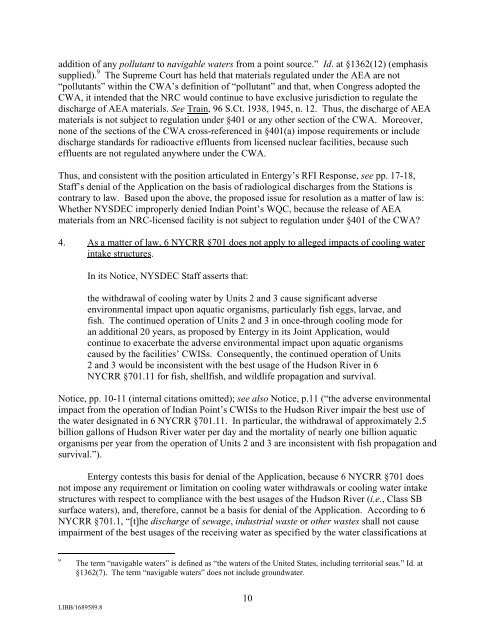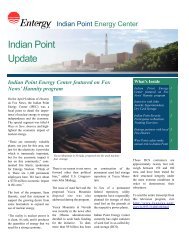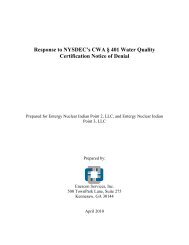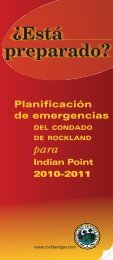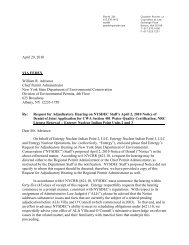Request for Adjudicatory Hearing On Notice of Denial - Indian Point ...
Request for Adjudicatory Hearing On Notice of Denial - Indian Point ...
Request for Adjudicatory Hearing On Notice of Denial - Indian Point ...
Create successful ePaper yourself
Turn your PDF publications into a flip-book with our unique Google optimized e-Paper software.
addition <strong>of</strong> any pollutant to navigable waters from a point source.” Id. at §1362(12) (emphasis<br />
supplied). 9 The Supreme Court has held that materials regulated under the AEA are not<br />
“pollutants” within the CWA’s definition <strong>of</strong> “pollutant” and that, when Congress adopted the<br />
CWA, it intended that the NRC would continue to have exclusive jurisdiction to regulate the<br />
discharge <strong>of</strong> AEA materials. See Train, 96 S.Ct. 1938, 1945, n. 12. Thus, the discharge <strong>of</strong> AEA<br />
materials is not subject to regulation under §401 or any other section <strong>of</strong> the CWA. Moreover,<br />
none <strong>of</strong> the sections <strong>of</strong> the CWA cross-referenced in §401(a) impose requirements or include<br />
discharge standards <strong>for</strong> radioactive effluents from licensed nuclear facilities, because such<br />
effluents are not regulated anywhere under the CWA.<br />
Thus, and consistent with the position articulated in Entergy’s RFI Response, see pp. 17-18,<br />
Staff’s denial <strong>of</strong> the Application on the basis <strong>of</strong> radiological discharges from the Stations is<br />
contrary to law. Based upon the above, the proposed issue <strong>for</strong> resolution as a matter <strong>of</strong> law is:<br />
Whether NYSDEC improperly denied <strong>Indian</strong> <strong>Point</strong>’s WQC, because the release <strong>of</strong> AEA<br />
materials from an NRC-licensed facility is not subject to regulation under §401 <strong>of</strong> the CWA?<br />
4. As a matter <strong>of</strong> law, 6 NYCRR §701 does not apply to alleged impacts <strong>of</strong> cooling water<br />
intake structures.<br />
In its <strong>Notice</strong>, NYSDEC Staff asserts that:<br />
the withdrawal <strong>of</strong> cooling water by Units 2 and 3 cause significant adverse<br />
environmental impact upon aquatic organisms, particularly fish eggs, larvae, and<br />
fish. The continued operation <strong>of</strong> Units 2 and 3 in once-through cooling mode <strong>for</strong><br />
an additional 20 years, as proposed by Entergy in its Joint Application, would<br />
continue to exacerbate the adverse environmental impact upon aquatic organisms<br />
caused by the facilities’ CWISs. Consequently, the continued operation <strong>of</strong> Units<br />
2 and 3 would be inconsistent with the best usage <strong>of</strong> the Hudson River in 6<br />
NYCRR §701.11 <strong>for</strong> fish, shellfish, and wildlife propagation and survival.<br />
<strong>Notice</strong>, pp. 10-11 (internal citations omitted); see also <strong>Notice</strong>, p.11 (“the adverse environmental<br />
impact from the operation <strong>of</strong> <strong>Indian</strong> <strong>Point</strong>’s CWISs to the Hudson River impair the best use <strong>of</strong><br />
the water designated in 6 NYCRR §701.11. In particular, the withdrawal <strong>of</strong> approximately 2.5<br />
billion gallons <strong>of</strong> Hudson River water per day and the mortality <strong>of</strong> nearly one billion aquatic<br />
organisms per year from the operation <strong>of</strong> Units 2 and 3 are inconsistent with fish propagation and<br />
survival.”).<br />
Entergy contests this basis <strong>for</strong> denial <strong>of</strong> the Application, because 6 NYCRR §701 does<br />
not impose any requirement or limitation on cooling water withdrawals or cooling water intake<br />
structures with respect to compliance with the best usages <strong>of</strong> the Hudson River (i.e., Class SB<br />
surface waters), and, there<strong>for</strong>e, cannot be a basis <strong>for</strong> denial <strong>of</strong> the Application. According to 6<br />
NYCRR §701.1, “[t]he discharge <strong>of</strong> sewage, industrial waste or other wastes shall not cause<br />
impairment <strong>of</strong> the best usages <strong>of</strong> the receiving water as specified by the water classifications at<br />
9<br />
The term “navigable waters” is defined as “the waters <strong>of</strong> the United States, including territorial seas.” Id. at<br />
§1362(7). The term “navigable waters” does not include groundwater.<br />
LIBB/1689589.8<br />
10


